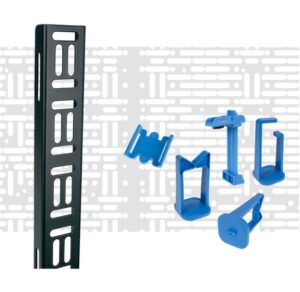Grow Your Business & Expand Your Reach: a comprehensive guide to Exertis Almo Commissioning Services
These finishing touches cover several bases, including fine tuning the devices and ensuring that the control system programming functions to the customer’s liking.
“Most of our [role] is supplemental – the ability for us to help our resellers amplify what they’re doing across the country with their own customer base,” Cory Allen, Director – VP of Services at Exertis Almo explained.
“Some groups may not have a resource in a particular area, so they have to send field commissioners or travel,” he added. “Our goal is to provide a supplemental resource by going to that location for them.”
Along with mitigating customer challenges associated with travel, commissioning services provide relief from the demands of the job on a single person.
“Field commissioning is very demanding on the individual, oftentimes with long hours and weeks of work,” said Allen. “We’re building a team to prevent one person from being out in the field for an extended period of time, allowing commissioners to move onto different projects while providing the integrator with fresh, focused help.”
The role requires a specific skill set, as the commissioner must have a hands-on approach to their work and be comfortable troubleshooting while successfully working alongside programmers and project managers. While each commissioner brings a different specialty, they are backed by the entire Exertis Almo team with a wealth of knowledge and a history with a variety of products, clients, and scenarios.
When compared with the installation process, there is a clear delineation between the two responsibilities. Installation provides the project’s function through the connection of hardware, whereas commissioning acts as the fine-tuning of the technology to ensure that the system is optimal for the customer.
“Not every system is alike, so we try to figure out the equipment and devices interacting with [the system] in our final checklist,” Allen explained. “Although we don’t require knowledge of every step of the project when quoting a customer, we should have a good idea of the steps we’ll need to take when we get on the job site.”
 When commissioning an audio system, a team member will push the audio through the system, checking the meters and DSP platform to understand the sound, and noticing any potential for distortion, echo-cancelling for video-conferencing technology, and more. Through this process, the commissioner tests the typical and atypical operations, ensuring that the system is performing correctly while educating the end user on how to correct any issues that occur.
When commissioning an audio system, a team member will push the audio through the system, checking the meters and DSP platform to understand the sound, and noticing any potential for distortion, echo-cancelling for video-conferencing technology, and more. Through this process, the commissioner tests the typical and atypical operations, ensuring that the system is performing correctly while educating the end user on how to correct any issues that occur.
On the control side, the process is much more straightforward. Touch panels are tested to ensure that they are functioning properly, and video signals are routed. By utilizing the tools provided by AVIXA standards, an Exertis Almo team member can efficiently commission a project and inform the installer on what problems need to be corrected.
Along with in-person work, Exertis Almo also provides remote commissioning for certain projects.
“We’ve been doing remote commissioning for a long time,” said Allen. “One of our programmers will remote-in to the system on TeamViewer, pushing the code and getting responses back if their actions don’t work.”
Although the process is remote on the commissioner’s side, the process requires someone on-site – usually the integrator – to complete the hands-on work with the system.
Regarding prices and quotes, the Exertis Almo team provides a rough estimate of travel, materials, and time to the customer. To minimize the travel required for various projects, Exertis Almo is working to construct a team in key locations throughout the country.
“The size of our team is based on demand, and as we begin to build and assess where most of our opportunities are, we will be able to better pinpoint these spots,” said Allen. “I expect us to expand a lot within a short period of time, and having this capability provides us reseller benefit from the bottom up, and top down from the manufacturers.”
In fact, a great deal of value in commissioning services lies in the end user training guides. By providing the customer with reference guides and answers to frequent questions, Exertis Almo provides customers with peace of mind – and the most complete understanding of their system.
This brings up a common question: If commissioning services are the final touches on a project, when is a project officially complete?
“A project is never 100% complete,” said Allen. “A project is finished when the scope-of-work list is complete, the system functions [as intended], and the client will likely be satisfied with the system.”
At Exertis Almo, we’re here to help you grow your business. Contact us to learn more about commissioning services for integrators.



 I’m in Business Development, or “Biz Dev” for short. It’s sometimes a difficult role to describe when people ask! I’ll take a stab at an answer…
I’m in Business Development, or “Biz Dev” for short. It’s sometimes a difficult role to describe when people ask! I’ll take a stab at an answer… Finally, I want to be a champion for the vendor and help spread their message to the target audience. Data analysis is a critical tool that I must employ to achieve these objectives.
Finally, I want to be a champion for the vendor and help spread their message to the target audience. Data analysis is a critical tool that I must employ to achieve these objectives. Armed with a few basic tools, I’m able to summarize trends and figures that answer questions like, “How can I be more profitable?” “What can I do to grow my revenue?” “Can I be more efficient by cutting out certain activities that don’t produce adequate results?” “Where should I focus my time for the greatest return?” And, perhaps most importantly, “what’s working and what’s not?”
Armed with a few basic tools, I’m able to summarize trends and figures that answer questions like, “How can I be more profitable?” “What can I do to grow my revenue?” “Can I be more efficient by cutting out certain activities that don’t produce adequate results?” “Where should I focus my time for the greatest return?” And, perhaps most importantly, “what’s working and what’s not?” Organize the data. What data are we interested in evaluating? Let’s look at customer name, location, revenue, profit, products sold, date (month). Next step…
Organize the data. What data are we interested in evaluating? Let’s look at customer name, location, revenue, profit, products sold, date (month). Next step…

 I worked for a company that had a product catalog 3 times the size of those old Sears catalogs from the 1980s. Inside, it had every little connector, cable, and electronic device you could possibly think of. As a new employee on the job, I was given this catalog as a “bible” to the job and told to “learn it.” Nonetheless, I was inquisitive as a new hire and would regularly ask my manager questions about what part was appropriate for the job I was working on. Without fail, my boss would always start his reply with “Rob, I know we have reviewed this,” before eventually guiding me on the solution. I would sit at my desk left to think how there was no possible way he had reviewed every part on every page in that catalog. To compound this even more, I had more than a decade of experience under my belt, so I came into the role with a decent foundation to start with. My mind then became trained to not go to that boss for future questions, because I did not like being made to feel as though I was always wrong or forgetful. While that experience did not completely eliminate my ability to ask questions, it certainly set me back some because, much like my daughter, became intimidated at the thought of asking because I didn’t want to be made to feel as though I was lesser or not good enough.
I worked for a company that had a product catalog 3 times the size of those old Sears catalogs from the 1980s. Inside, it had every little connector, cable, and electronic device you could possibly think of. As a new employee on the job, I was given this catalog as a “bible” to the job and told to “learn it.” Nonetheless, I was inquisitive as a new hire and would regularly ask my manager questions about what part was appropriate for the job I was working on. Without fail, my boss would always start his reply with “Rob, I know we have reviewed this,” before eventually guiding me on the solution. I would sit at my desk left to think how there was no possible way he had reviewed every part on every page in that catalog. To compound this even more, I had more than a decade of experience under my belt, so I came into the role with a decent foundation to start with. My mind then became trained to not go to that boss for future questions, because I did not like being made to feel as though I was always wrong or forgetful. While that experience did not completely eliminate my ability to ask questions, it certainly set me back some because, much like my daughter, became intimidated at the thought of asking because I didn’t want to be made to feel as though I was lesser or not good enough.
 Communication
Communication
 Rack systems play a crucial role in the Pro AV space, providing a structured and organized framework for housing audio visual equipment. These systems are essential for ensuring proper installation, organization, and maintenance of AV gear. When selecting rack products, there are several key factors to consider optimizing performance and efficiency. Investing in high-quality rack products is essential to maintain the integrity of your audio-visual equipment. With their sturdy construction and robust materials, these racks can withstand the rigors of daily use, safeguarding your valuable AV gear and reducing the risk of equipment failures or damage. The idea here is to organize and protect your AV equipment, which is worth thousands of dollars, so don’t always look for the least expensive option.
Rack systems play a crucial role in the Pro AV space, providing a structured and organized framework for housing audio visual equipment. These systems are essential for ensuring proper installation, organization, and maintenance of AV gear. When selecting rack products, there are several key factors to consider optimizing performance and efficiency. Investing in high-quality rack products is essential to maintain the integrity of your audio-visual equipment. With their sturdy construction and robust materials, these racks can withstand the rigors of daily use, safeguarding your valuable AV gear and reducing the risk of equipment failures or damage. The idea here is to organize and protect your AV equipment, which is worth thousands of dollars, so don’t always look for the least expensive option. Another critical aspect is ventilation. Adequate airflow is essential to prevent equipment overheating, which can lead to performance issues and even equipment failure. Look for rack products with proper ventilation options such as vented rack shelves, perforated doors, or integrated cooling fans. These features facilitate the movement of cool air and help dissipate heat generated by the AV equipment, ensuring optimal performance, and prolonging the lifespan of your gear. Would you like to be stuck in a room with loads of running electrical equipment and no air flow to cool it down? This sounds like the worst sauna in the world. Now, imagine what poorly ventilated racks can do to your valuable AV equipment. Not a pretty thought!
Another critical aspect is ventilation. Adequate airflow is essential to prevent equipment overheating, which can lead to performance issues and even equipment failure. Look for rack products with proper ventilation options such as vented rack shelves, perforated doors, or integrated cooling fans. These features facilitate the movement of cool air and help dissipate heat generated by the AV equipment, ensuring optimal performance, and prolonging the lifespan of your gear. Would you like to be stuck in a room with loads of running electrical equipment and no air flow to cool it down? This sounds like the worst sauna in the world. Now, imagine what poorly ventilated racks can do to your valuable AV equipment. Not a pretty thought! Lastly, consider the overall build quality and durability of the rack products. Look for racks made from sturdy materials like steel or aluminum that can withstand the weight of equipment and provide long-lasting reliability. Robust construction not only ensures the safety of your AV gear but also reduces the risk of equipment damage during installation or transportation. Fortunately for us, our partners at Legrand offer a whole suite of rack products through their
Lastly, consider the overall build quality and durability of the rack products. Look for racks made from sturdy materials like steel or aluminum that can withstand the weight of equipment and provide long-lasting reliability. Robust construction not only ensures the safety of your AV gear but also reduces the risk of equipment damage during installation or transportation. Fortunately for us, our partners at Legrand offer a whole suite of rack products through their 






